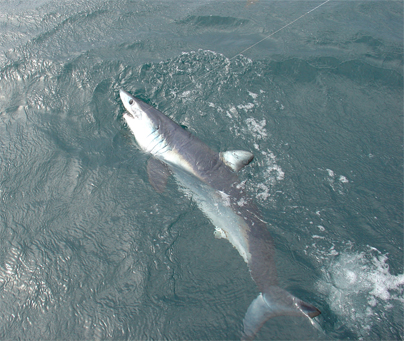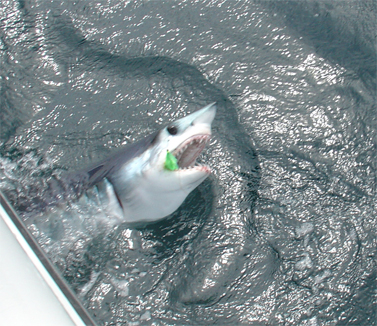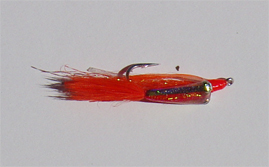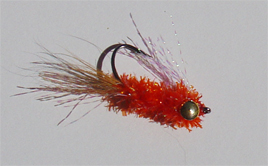

For early summer vacation we decided to head to Mission Beach for some sun, surfing, and, for me, fishing. I decided to do the whole enchilada this year - fish the beach every day and also get in a trip offshore for sharks and a trip inshore in San Diego Bay. My goal was to catch a Mako on the fly and to finally figure out the corbina fishing in the surf. Three years ago my first saltwater fish was a corbina from Mission Beach and I hadn't managed to catch one since that day, or consistently catch perch. After we got our rental car, found our condo, and bought groceries I headed to the beach for the evening surf fishing. At the surf beach at Mission Point I made about 6 casts and was into the first of many surfperch for the trip. Two casts later my 7-weight snapped, all I could do was walk home with my only surf rod broken. I got on the phone and the net to see if I could find a fly shop open on Sunday to get a new rod.

Our condo at Mission Point
Sunday we picked up Marshall from his basketball tournament at the University of San Diego and headed to Solano Beach and The San Diego Fly Shop where I picked up a new Sage 690 XP for the surf. We then got back, unpacked Marshall, and headed to Old Town o meet Catherine's family for dinner at our favorite Mexican restaurant, Casa Guadalajara. That evening I hit the beach again to try out the XP and got 4 perch in about 45 minutes of fishing between the weeds which were all over the beach.
Monday morning I met Peter Piconi at Belmont Park at 5:30 a.m. for some coaching on how to read the surf better to increase my odds with corbina and perch. Walking out of the parking lot to the edge of the sand even I could read the beach, the tide was way out and the big holes were outlined clearly. We started at the big hole at lifeuard station #13 and Peter showed me how to approach the fishing by starting at a 3:00 position on the hole and working around to a 9:00 position slowly, carefully hitting the edges. At the 9:00 spot, working the fly back along the edge I got a good take and quickly realized I was into my second ever corbina. I landed the 18-19" fish and let him go, no corbina photos, it is too hard to carry a camera in the surf. Working up the beach we hit each successive hole picking up some perch along the way. As the tide came up many of the big holes became less defined as they filled with water so we began looking for parallel rips which showed troughs coming out of the holes and used as fish passageways to the food on the beach. At one such spot I got into a good group of perch and landed 6-7 from the same spot, it was just a matter of getting the right cast and drifting into a bathtub sized area and a perch almost always took. The wind had picked up and gotten pretty difficult so Peter taught me the Belgian, or tension, cast which works great on the beach with a shooting head line. By 10:00 the beach was full of water, surfers, sunbathers, and swimmers so it was time to switch from fishing the surf to riding it. We got Marshall out of bed, finally, and headed out to rent a board for him. We ended up buying a board instead, Marshal's first fiberglass short board, and took off for the beach where he tried out the new board while I hit the waves with a boogey board.
Tuesday morning I was off to Dana Landing to meet Dave Trimble from Bowman Bluewater at 6:30 a.m. for a day chasing sharks offshore. The weather looked encouraging on Mission Bay with clear skies and little wind. We got chum, loaded the boat, and took off out of Mission Bay into the swell of the Pacific Ocean. We motored out about 10 miles to some blue water and began setting up. Dave got the chum slick going and rigged up the 14-weight while I got the 10-weight rigged for smaller fish. I used a floating line, a 20 lbs. class tippet and about 2' of 50 lbs. Tyger Wire for a bite tippet with a 2/0 Sea Habit White Knight for a fly. Before we were done we had a 30 lbs. mako up on the chum bucket and he was soon followed by two blue sharks, one very small and one probably 25 lbs. The mako was bisy chasing the blues so the plan was to catch the blues so that the mako would settle down to chase the teaser which was a dead mackerel. The trick here was to get the shark on the teaser, cast the fly close to the teaser, yank the teaser and wait for the shark to turn around and, hopefully, take the fly. Dave got the smaller blue interested and I got off a good cast, got a strike and was into the fish but soon realized I had snagged him in the tail and hadn't hooked him in the mouth, evidently a common problem with blue sharks since their mouths are so far back. I let him pull a bit then just tried to pull the hook out which worked. One blue down, one to go but before I got that one to chase another had joined the party. The next small blue took and put up a pretty good fight before coming to the boat and getting unhooked. One blue left and about that time we noticed the lightening forming o our inshore and saw the rain coming at us. The big blue took and was off to the races just about when the rain hit, the wind picked up and the seas got rough. As I was fighting the fish a Navy shipped passed to our side and the back wake mixed with the swell and wind took my hat of and into the water which Dave managed to snag. After a good fight the blue came to the boat and was quickly released.

Now the weather was ugly and the sea rough but we had two big makos cruising around, occasionally putting their heads into the chum bucket trying to steal it. I put the 10-weight away and grabbed the 14-weight which was rigged with a fly that looked like a chartreuse hackle neck tied onto a 7/0 hook. Dave worked at teasing the makos p while I tried to cast the big fly into a 25 knot wind, not easy when you are only trying to make a 15-25' cast. The bigger fish, probably 200+ lbs. took but when I stripped I didn't connect - I wasn't sure whether to be upset or relieved, I wasn't too sure that fish could be landed. I felt like I was in Jaws saying, "We need a bigger rod" instead of needing a bigger boat, though a bigger boat would have been good too. The smaller shark, a 125 lbs. one, finally showed some interest and I got off a good cast, he circled back, took the fly, turned and I struck then struck again a few times tarpon-style just to be safe. Now the real fun began. For the first 20 minutes or so the shark stuck fairly close to the boat and did some circling which was tough given that the boat was rocking all over the place in the swell. We actually got him to the boat and grabbed the leader at one point but he was still a bit hot to try and release, we did not want a shark that big in the boat with us by accident. The bigger fish was still heads up to the chum bucket which kept my fish a bit skittish too so he finally took off greyhounding towards Mexico with my flyline and most of my backing. We had a choice to make - break him off or pull up the chum and go chase him. Given the weather conditions we decided to chase figuring this was the one big fish of the day. Off we went and finally I was gaining back some backing on the reel. We chased the shark for another 15 minutes before I started really putting on some pressure. At that point the fight got a bit easier as I was able to get the shark up near the surface and do a little of the old "down and dirty" to put on maximum pressure. Finally he was close to the boat and we got a few shots and then I was able to get him up for release.

 |
 |
| Finally, the battle was over | Time for release |
After that we gave up and started the long, wet, and rough ride back to Mission Bay. In four hours of fishing I managed to land 3 sharks including the Mako which was the biggest fish I'd yet to land on a fly rod. I spent the rest of the day hanging on the beach taking it easy with Catherine and her parents.
On Wednesday I met up with Peter again but this time at Glorietta Bay on Coronado Island for some fishing in San Diego Bay. I had fished the front bay by Shelter Island a few years back and had a blast but this time we wanted to hit the flats in the back area of the bay. We started out near the bridge and I got a Yellowfin Croaker out of a group of fish that was chasing bait around. We headed towards the front bay waiting for the tide to fill the back area and got into bass around Shelter Island. I got one really nice barred sand bass that put a good bend in the 6-weight rod.

After a few more barred and spotted sand bass we chased some marauding bonita or cuda around but never managed to get off a cast to them. We then headed to the flats in the back bay where the bass were plentiful and I also got a Pacific Mackerel. We consistently got fish everywhere we went that day and I lost count of the number of bass that we got to the boat.
The rest of the week - Thursday to Saturday - I spent fishing the beach in the morning and some in the evening. On Thursday morning I managed 3 corbina, one of which went 19-20", and that evening got a half dozen nice surfperch and one shovelnose guitarfish. On Friday morning I got 2 more corbina including a huge 21" fish and a half dozen surf perch. Saturday was my last chance to fish and it was much harder in the surf - the surf was huge that morning and the tide was higher so the good holes were not too well defined. I fished a few hours and was getting ready to leave when I finally hooked up a nice corbina which I released and then headed back to the car.
This was one of the best fishing trips I'd ever had and most of it involved walking one block to the beach from the condo we stayed at. San Diego may not come to mind as a fishing destination but that changed for me on this trip. It has it all - beach fishing for fish that are every bit as tough as permit, bay fishing for whatever happens to be swimming around, and offshore action with fish that could eat you given the chance. While this is the fourth or fifth time I've fished down there I have never had a better time and I learned a lot on this trip that should make my fishing there much more productive in the future.
Luckily you don't need to carry too much gear since the beach and bay use the same exact equipment with different flies. Offshore you can probably get by without a rod at all if you don't mind using the rods that Dave and Conway have, assuming they haven't broken them all.
For beach fishing you want a 6-7 weight rod. I found that the Sage 691-4 XP was the perfect rod, in fact it seems to be the most popular rod sold at the San Diego Fly Shop and Peter had a whole collection of them. For reels any good saltwater ready reel will work, I used my Ross Canyon 4. Lines are all shooting head-style lines ranging from 200-350 grains. I started out with a 200 but moved to a 300 which worked way better in the fast currents. Leaders are simple - I used about 18" of 25 lbs. and then 24-30" of 0x Flourocarbon tippet. A stripping basket is essential, don't leave home without it.
I had all my luck on attractor style flies this trip and orange seemed to be the color. I caught all my fish on two flies - one was an epoxy fly that Peter sells at the shop, the other was a Beach Bug by Jay Murakoshi.
 |
 |
For the bay the same rod can be used with same lines. You may want to carry a floating line or a full intermediate too for when the fish are in shallow water on the flats. The intermediate worked pretty good at times and at other times we needed 200 grains to get down to the fish. For flies it was all baitfish patterns. I used a Clousers in chartreuse, and some grey-backed streamers that Peter had.
Here you want 2 rods ideally - a 10-weight for small sharks and a 14-16 weight for the big boys. Have lots of backing and a floating line. For the 10-weight I used a leader built with a 40 lbs. butt, a 30 lbs. section, a 20 lbs. class tippet and a 2' piece of 50# Tyger Wire for the bite tippet. For flies I used a 2/0 Sea Habit White Knight though any baitfish pattern would probably work. On the big rod we had a 20# class tippet with single strand wire for the tippet. Dave had huge chartreuse flies that he preferred and they definitely worked.